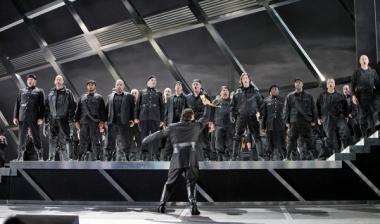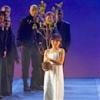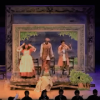
One of the many dramatic high points of Richard Wagner’s Der Ring des Nibelungen (The Ring of the Nibelung) is near the end of the humongous opera cycle when — spoiler alert — the evil Hagen kills the (erratic) hero Siegfried.
Anybody who ever saw the Ring will forever remember the scene as members of the chorus, awestruck, demand of the killer: “Hagen! Was tust du? Was tatest du?” — “What are you doing? What did you do?”
And so, five weeks before the beginning of the company’s 2018 Ring cycles, some 80 members of the San Francisco Opera Chorus gather in the Lotfi Mansouri Chorus Room in the War Memorial, ready to rehearse with Chorus Director Ian Robertson, whose tenure stretches 31 years.

But first, Robertson — recipient of the company’s top honor, the San Francisco Opera Medal — tells the visitor about the peculiar situation in which the chorus finds itself. Wagner, who wrote so many prominent roles for the chorus, from his earliest (Rienzi) to his latest (Parsifal), neglected the chorus in the Ring so completely that it doesn’t appear at all in the first three operas.
“Then they have this important role in Götterdämmerung, but it’s just about 10 minutes,” Robertson says. That’s 10 minutes in a work that has more than 14 hours of music, the four operas taking 17 hours to perform, including intermissions.
How far that is from the chorus’s starring role in Berlioz’s Les Troyens, when its members sang for two hours at each performance of the five-hour work! Still, Robertson rephrases Stanislavski’s “there are no small parts, only small actors” by saying — and then demonstrating at the rehearsal — that the chorus is preparing for the Ring by working as hard as ever.

At the rehearsal, the 24 women in the chorus are let go early, having been praised by Robertson and SFO German diction coach Marianne Barrett. “They have 16 notes in the score,” Robertson explains. Fifty-four men remain to work on their more substantial role.
But don’t cry for the chorus, Argentines, the truth is, they never leave you. Rehearsals will soon start for the fall season, when the Opera Chorus has important roles in the Cavalleria Rusticana / Pagliacci double-bill, Tosca, Roberto Devereux, Arabella, the Jake Heggie premiere It’s a Wonderful Life, and Carmen.
And, even during the Ring, Robertson and the Opera Chorus will be very much present Thursday nights across the courtyard from the War Memorial, in the Veterans Memorial’s Wilsey Opera Center, with three concerts of Wagner choruses — June 14, 21, and 28.

Robertson programmed a chronological exploration of Wagner’s choral music, from Rienzi to Parsifal (although ending with Die Meistersinger “because you need something with more oomph for the finale”). The concerts also feature choral excerpts from Tannhäuser, Lohengrin, and The Flying Dutchman. Robertson conducts the singers, who are accompanied by Associate Chorus Master Fabrizio Corona at the piano.
Robertson will also be busy in his continued role as artistic director of the San Francisco Boys Chorus, which is celebrating its 70th season this year. The organization’s spring anniversary concert will be held on June 2 in the Yerba Buena Center for the Arts Theater. Merola alumna Leah Crocetto, now a world-renowned soprano, is guest artist, performing “Vissi d’arte” from Tosca, spirituals, and pop songs.
The boys will sing a wide-ranging program, from a Japanese fishermen’s song to a Scandinavian folk melody, a song from the movie Frozen, and much more.
The Grammy Award-winning Boys Chorus, founded in 1948 as the first boys repertory chorus in the nation and participating in S.F. Opera performances ever since, will continue to celebrate its anniversary on Dec. 8. Robertson will lead the chorus at Calvary Presbyterian Church, in a program yet to be announced.





